Transcript
1
The Healing Power of Namo’Valokiteshvaraya Chant
Your excellencies, and distinguished guests, Plum Village Brothers and Sisters will start by invoking the name of the Bodhisattva of Deep Listening and Great Compassion in Sanskrit, “Namo Avalokiteshvaraya.” “Avalokiteshvaraya” means someone who has freedom thanks to meditating and looking deeply, and thanks to listening deeply and carefully.
Bodhisattva Avalokiteshvara symbolizes love and compassion inside each of us. When invoking the name of Bodhisattva Avalokiteshvara, we get in touch with that energy of love and compassion that are innate in each of us, and we generate a collective energy of love and compassion. It will nourish everyone and all beings.
Well, we invoke her name with our hearts — not just words. And the invoking of the bodhisattva’s name generates a collective energy. If we are truly present in the here and now with our hearts open, that energy will sink into our body as well as our mind, heart, and soul.
If we suffer pain or sickness in the body, if we let this energy sink in, this energy will transform tension and pain in the body. And if we have suffering and pain in our soul, if we’re truly present with our hearts open, this energy will sink in and transform those sufferings and pains.
If we have a loved one who is suffering a serious illness, who is now in a hospital, a medical center, or somewhere like that, we can also send this energy to that person by thinking of them and silently calling their names, this energy will be sent their way in almost no time. In Vietnamese, it’s “Nam Mô Bồ Tát Quan Thế Âm.” In Sanskrit, it’s “Namo Avalokiteshvaraya.”
So now, here are the Brothers and Sisters.
[Bell]
[Bell]
[Bell]
[Touching the bell]
[Namo’Valokiteshvaraya — Chant in Vietnamese]
🎜♫ From the tip of the willow branch hangs a drop of compassionate nectar.
A single drop of this nectar is already enough to douse the fires in the ten directions.
All afflictions vanish.
The sacred altar is right here.
Homage to you Refreshing Earth Bodhisattva.
Homage to you Refreshing Earth Bodhisattva.
Homage to you Refreshing Earth Bodhisattva. 🎜♫
🎜♫ From the depths of understanding, a flower of great eloquence blooms.
The Bodhisattva stands majestically upon the waves of birth and death, free from all afflictions.
Her great compassion eliminates all sickness, even that once thought of as incurable.
Her wondrous light sweeps away all obstacles and dangers.
The willow branch, once waved, reveals countless Buddha lands.
Her lotus flower blossoms a multitude of practice centers.
We bow to her.
We see her true presence in the here and now.
We offer her the incense of our hearts.
May the Bodhisattva of Deep Listening embrace us all with Great Compassion.
Homage to you Bodhisattva of Deep Listening and Great Compassion.
Homage to you Bodhisattva of Deep Listening and Great Compassion.
Homage to you Bodhisattva of Deep Listening and Great Compassion. 🎜♫
[Namo’Valokiteshvaraya — Chant in Sanskrit]
🎜♫
[Bell series]
2
Mindfulness: a universal practice
Zen Master Nhất Hạnh’s Dharma Talk With Intellectuals
— Quy Nhơn City (Bình Định, Vietnam), April 07, 2005
I feel life in me and around me.
Breathing out, I smile at life in me and around me.
[Bell]
[Bell]
[Bell]
Dear friends, in recent years, we’ve established in Europe and the US Mindfulness Practice Centers, or Maison de la Pleine Conscience in French.
In these mindfulness practice centers, there are no Buddha statues, there’s no incense, and there are no religious ceremonies. Everyone can come to practice sitting, walking, drinking tea, and eating in mindfulness. So those who have Jewish roots, Christian roots, or Hindu roots can come to these practice centers as they see fit because these practice centers are not religious — they don’t look or sound religious.
Sit in such a way that while sitting, there’s inner peace and happiness. That’s what we should practice. In Vietnamese, it’s called “an tọa” — still sitting. Sit in inner ease and peace. Because among us, many cannot sit still.
Walk in such a way that each step brings us solidity, freedom, and happiness. Many of us cannot walk like that. We walk as if being chased by ghosts. We always walk in a rush and at full tilt, and we don’t feel happy with each step.
When we drink tea, drink in such a way that we can get in touch with the miracles of life and with the company of those who are sitting with us. Tea times can bring us nourishment, happiness, and inner peace. The same with mealtimes.
Mindfulness practice centers are places for those who are not seeking consolation in any religion or faith, but the ways or the art to live every moment of their lives deeply, peacefully, and happily.
When we go to the West, we know they’ve already had their religions. That’s why we only want to offer them the non-religious part of Buddhism. Because Buddhism can be conducted as a religion, with beliefs, praying, and faith in the future. But Buddhism is not only that. In Buddhism, there’s a source of deep insights.
In Buddhism, there’s a source of remarkable insights, and there are good practices that help us untie knots of suffering and pain, relieve us of what’s gnawing at us, and allow us to re-establish communication with those we love, bringing about happiness.
These are the things we’ve shared with friends in the West — in Europe and the US.
In forty years, we’ve established numerous practice communities in many cities in Europe and the US.
At first, they come to us because they don’t have inner peace. When applying themselves to the practices that we suggest, they achieve contentment and joy. They can reconcile themselves with themselves, and with their loved ones. Happiness can find its way back into their families. And they can get rooted again in their native spiritual tradition and society.
We’ve never wanted people to lose their roots. We said, “Don’t forget your roots, because a rootless person is an unhappy person. If you are a Christian, please continue being a Christian. You can adopt Buddhist practices to untie the knots of your difficulties, sufferings, and pains that have been gnawing at you for so long. Then, return to your spiritual roots — your spiritual traditions, to renew and revive and to discover the treasures in your traditions that you haven’t discovered yet.”
For that reason, our attitude is totally different from that of the clergypeople who came to Vietnam during the centuries when they first came and promoted their beliefs and religions. We never want them to abandon their native spiritual traditions.
On the contrary, we encourage them to keep those roots. Coming into contact with this attitude, they grow fond of Buddhism because, in it, there’s an openness and a great degree of inclusiveness.
Instead of talking people into abandoning their religions or their spiritual traditions, and following ours, we encourage them to keep their roots. We do just the opposite of what the Christian clergy did in Vietnam around 300 or 400 years ago.
For that reason, they get to be in touch with the beauty of Buddhism, with the all-embracingness and openness of Buddhism. And they come to really appreciate it.
In Vermont, we have a mindfulness practice center like that. And those who look after and take care of that center are ordinary people. They aren’t Buddhists — they don’t have to, but they know the art of sitting that allows them to have inner peace and contentment, the art of walking that allows them to have inner peace and contentment, and the art of living that allows them to live deeply each moment of their daily life.
3
Are Billionaires Happy?
That one day, on a riverbank, there was an old man. He was sitting on the riverbank reading my book. That book was Peace Is Every Step. The old man looked weary and dressed very simple. The book he was holding in his hands was extremely worn. Perhaps he had been reading it for years — it was an old tattered book with curled pages.
One of my disciples happened to go by this old man as he was sitting on the riverbank, reading by himself. That disciple, who was also an American, stopped by and said,
“You know, there’s a mindfulness practice center nearby founded by my teacher. If you’re interested, I can drive you there so you can practice mindfulness with like-minded friends. Because I see you’re reading my teacher’s book, I think it’s a good idea to invite you there.“
Well, that old man said nothing. He just gave an acknowledging nod and cast his eyes down, continuing reading.
So that disciple said, “If you don’t have a car, I can give you a ride there to our mindfulness practice center.“
He then said, “Thank you, I’m good. Maybe another time.“
After staying on for a bit more, that disciple said, “Well, if you can’t make it today, let’s make it another day. But could you please let me know your name and address so if there’s a Day of Mindfulness, I can go there and pick you up?“
So the old man took out a business card from his bag. The card read, “Laurance Rockefeller,” one of the top billionaires in New York.
In the US, some people are very wealthy, and very powerful but are not happy. We, especially young people, tend to believe that only when we have a lot of money and a lot of power, can we be happy. However, in this case, we see that there are those like Laurance Rockefeller who are among the world’s wealthiest and most powerful but obviously don’t have happiness.
I wonder how come, when in pain, when he didn’t have happiness, he didn’t find consolation in his spiritual tradition, in Christianity, but in reading a book written by a Buddhist monk. That’s a question that comes to my mind.
I also met William Ford Jr. (aka Bill Ford), chair of the famed carmaker Ford Motor Company. He is the fourth generation of the Fords (to run the company). He came to our monastery to learn and practice mindfulness. He also practiced mindful sitting, mindful walking, and eating in silence. After finishing his meal, he also did his dishes like the Brothers, Sisters, and other lay friends in Plum Village.
I gave him a little bell to practice mindfulness at home. I shared that, “Every time we hear the bells, we stop all thinking and all inner talking, coming back to our breathing. We practice breathing in such a way that restfulness, calm, and reconciliation in the body as well as in the soul can come about.“
So, over tea, Bill Ford shared with me to a great extent about the life of billionaires in the US. According to Mr. Ford, those wealthy people were very lonely, that they were full of suspicion, that they were full of fears. For that reason, they never felt genuinely happy.
The story of Frederick
We usually organize 7-day retreats for businesspeople and entrepreneurs in Europe and the US. Well, we know that these businesspeople and entrepreneurs were enormously powerful and wealthy people. But through these 7-day retreats, it proved that many of them were not at all happy. Just the opposite, they experienced great suffering and pain.
There was a German entrepreneur named Frederick. He was extremely successful in his career. At first, his wife, Claudia, was very happy because she got married to such a young, successful, and well-known entrepreneur. Every time guests were coming, she was very proud to receive them as his wife.
But that happiness didn’t last for long because Mr. Frederick’s career took over his life. Day and night, his only concern was his career so he didn’t have time to enjoy life, he didn’t have time to love and care for his wife and son. That’s why his wife and son began to suffer.
His wife and son, Claudia and Thomas, always complained that he was never there for them. Every time he was home, his body was there, but his mind was elsewhere.
And the day Thomas had to be in the hospital for surgery — major surgery, Frederick — Thomas’s father, couldn’t make it to the hospital. He was that busy. When it was wife Claudia’s turn to be in the hospital, Frederick couldn’t make it, either. He was that busy.
He didn’t have time to breathe. He didn’t have time to live for himself. He didn’t have time to take care of his loved ones.
One day, Claudia cried. She cried in the dark. Frederick said, “Honey, please, please give me more time. At the moment, nobody in my company can replace me. I’ll try my best within 3 or 4 years to find someone who can succeed and replace me. Then I’ll be here for you and our son.”
He made a very solemn and faithful promise. But two weeks later, he was killed in a car crash, when he was 51.
Claudia was there in the retreat organized for businesspeople and entrepreneurs. She recounted this story for all of us there to listen.
Living in the moment
Wealthy people and powerful people have little time to live and they don’t have time to take care of and to love their loved ones. That’s the truth. I don’t know if any of you here are very wealthy or powerful, but perhaps at some point in your life, you’ve already gone through this kind of experience yourself, more or less. That is, if we’re too busy, we don’t have time to live and take care of those we love.
In the morning, we don’t have time to look at our wife, husband, partner, son, or daughter. At lunchtime, we may not have the chance to eat together with our family. And in the evening, after a long day at work, we get home, completely spent, disgruntled, or ready to drop, literally having no energy left to be able to notice our loved ones are still there alive, to offer them a loving smile, to take care of them.
Not to mention there’s TV. After calling it a day at work, we watch TV. Instead of looking at each other to see how our loved ones are after a day not seeing each other, we look at the TV. And with that, we call it a night. Twenty-four hours of a day go by like a dream. And that’s the reality of how life nowadays is.
We’ve industrialized. We’ve modernized. We’ve had advanced science and technology. We can make a lot of money but our happiness is very little compared with that of our parents, grandparents, and many far-back generations.
In the past, our parents and grandparents had time to drink tea with each other. They had time to view foliage in the woods together. They had time to care for orchids.
Sometimes they get into a boat and row it to a lotus pond at the crack of dawn, when the mist hasn’t lifted yet. Then they open the lotus petals to retrieve the tea leaves that they put in the day before. Sitting in their boat, they make tea and drink tea in the early morning mist.
Now we don’t have time to do all of these.
In what way Buddhism can be of help for this situation — a situation where everyone is constantly pushed for time and gets rushed off their feet, never having time to live for themselves, and never having time to take care and to love those they love?
The World-Honored One — the Shakyamuni Buddha, once said, “The past no longer is. The future has not yet come. There’s only one moment that we can truly come in touch with life. That is ‘this’ moment — the present moment.”
“Do not pursue the past.
Do not lose yourself in the future.
The past no longer is.
The future has not yet come.
Looking deeply at life as it is in the here and now,
the practitioner dwells in stability and freedom.”
That’s what Shakyamuni Buddha said. This teaching by the Buddha is about our ability to train ourselves to live deeply each moment of our daily life. Because according to this teaching, “the past no longer is, the future has not yet come.” If we trample on the present moment, we’re squandering our life.
We have an appointment with life. That appointment — that rendezvous, is in this moment, the present moment. But if we strive in pursuit of a goal, trampling down the present moment, to be somewhere in the future, we’re squandering our chance to live now. Busy people are those who cannot live in the moment. Busy people are those who rush to the future. In Frederick’s case, it’s the truth.
4
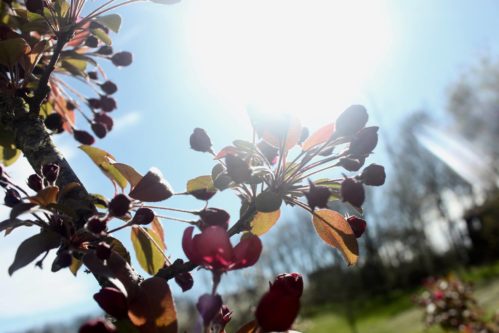
Perhaps, let’s say, among the 10 people who are watching a majestic sunset together, there are a few people who can dwell peacefully in that moment and be in touch deeply with the extraordinary sunset beauty. Yet, some are also there but their minds are not there. Their minds are thinking about what happened or worrying about what will come.
To those who are unable to live in the moment, those who are living in anticipation, worry, and fear of the future, or in regret and sorrow thinking of the past, even though they stand in the same place as the other 9 people, that majestic sunset view is not for them.
The same with us. The marvels of life like the open blue sky, the scudding white clouds, the warbling birds, the cheering trees, the blooming flowers — all are happening in the present moment. But because we’re striving in pursuit of a goal in the future, we can’t get in touch with all those marvels. With that, our life will be but a dream in the end.
Buddhist insights in the Vietnamese classic “The Tale of Kieu”
Perhaps you still remember the two lines in The Tale of Kieu that poet Nguyen Du wrote to describe this truth. That day, Kieu’s parents & siblings were going to a birthday party of someone on her mother’s side. But Kieu feigned a headache to stay at home. Indeed, she wanted to spend time with her boyfriend who was living right next door.
Well, the first time she went over to his house, she spent almost all day living with Kim-Trong. So when the sun began to go down, she thought she’d been hanging out with him all day long already. Maybe a bit too much. So she bade Kim-Trong goodbye to go back home and see if her parents or siblings were already back. Well, none of them were.
Kieu regretted. She closed the window curtains and went over to Kim-Trong’s place the second time. At that moment, the moon began to rise. At that moment, Kim-Trong was resting after a long day living with Kieu with a gamut of emotions.
He was sleeping sitting up at his desk. The sound of Kieu’s approaching footsteps woke Kim-Trong up. His mind was in a muddle, he wasn’t sure if this was Kieu in flesh and bones, or only her image in his dream.
“Wondering whether it’s Peak Giáp or Mount Thần,
He thinks it’s a dream, still being in a muddle from the Spring night sleep”

Kim asked, “Sweetie, is that really you? Or are you just an image in my dream?” He asked so.
“Wondering whether it’s Peak Giáp or Mount Thần” means he was half-awake, half-asleep.
“He thinks it’s a dream, still being in a muddle from the Spring night sleep.” Seeing Kieu in her white gown approaching, well, he wondered if his girlfriend really went over to see him the second time, or if it was just an image in his dream.
Then the poem goes,
“She admits: “In the empty void of a long night, because of flower, I have to blaze a trail to come to see flower.
Now the pair of us is unmistakably holding each other’s gaze, yet who knows it’ll become but a dream anon?” ”
These two lines are so superb. These lines are very Zen. They mean, at this moment, we have the opportunity to behold each other, to come to a stark realization that the other person is still present. Now, at this moment, we have this precious opportunity to behold each other. However, if we lose this opportunity, everything will be but a dream.
“Now the pair of us is unmistakably holding each other’s gaze, yet who knows it’ll become but a dream anon?”
Let’s think again, asking ourselves, “With whom am I living?” We’re living with our father, mother, partner, girlfriend or boyfriend, husband, wife, or children.
We’re too busy to look each other in the eye in the morning. We don’t have time to say something nice to each other in the afternoon. And in the evening, when we get home completely spent, we can’t even recognize that our loved ones are still there alive.
If we continue to live this way, what will happen? What will happen is that our life will end up being but a dream.
[Bell]
Love means being truly present
There was an eleven-year-old boy whose dad is extremely wealthy. His mom whispered to his dad, “Honey, tomorrow is our son’s birthday. Please don’t forget to buy him something.”
Well, this businessman turned around and asked his son, “My son, is it your birthday tomorrow?”
“Yes, Daddy.”
“Whatever you want for your birthday, I’ll get you.”
That’s what he said. The young boy knew too well whatever he wanted, his daddy would get him because he was extremely wealthy. But he didn’t want anything because he had had more than enough. All the items that his dad bought filled up his toy room, but he never touched them.
He was an unhappy little one because his dad was never there for him, and never spent time playing with him. His dad was never there for him. He had a father but it felt like he had never had a father because the father was too busy. The father didn’t have time to live for himself. The father didn’t have time to take care of his wife and his child.
That’s the situation of many of us, even though we’re not a tycoon like the other man.
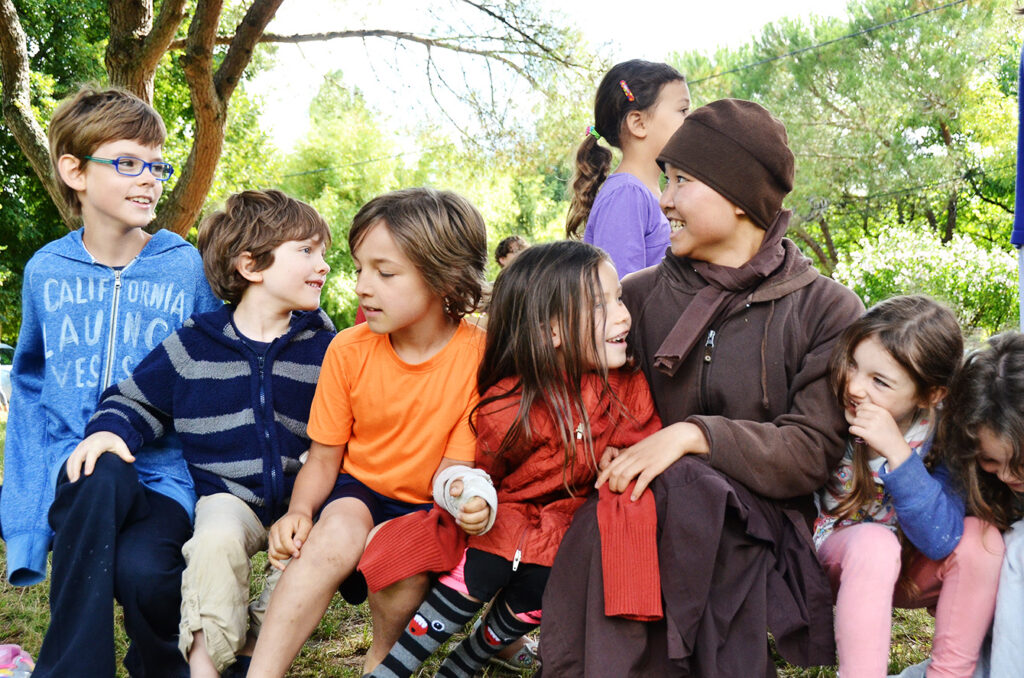
According to Buddhist insights, the most precious gift we can ever give to our loved ones, to our beloveds, to those we love the most in this world, is our presence. Money is not the most precious gift. Some people bring a lot of money home but those at home are not at all happy because the ones who bring money home are not truly there for them.
Without the husband’s presence, without the father’s presence, how can a wife, or a child, be happy?
Work has hypnotized that person. If the other father knew how to practice mindfulness, he would do what a Plum Village practitioner would. He would only need to take one mindful breath.
“Breathing in, I know that I am breathing in. Breathing in, I’m in touch with life in me and around me.
Breathing out, I’m aware that my wife and my children are there.”
It only takes one breath for him to bring his mind back to his body, and to be truly present. Being truly present in our life is a Zen practice. In our daily life, our mind isn’t in the same place as our body. Even though the body is there, the mind is somewhere else.
Zen, first of all, means bringing the mind back to the body. Once the mind comes home to the body, we are truly present in the moment. Being present in the moment, we come in touch with the miracles of life at that moment. Those miracles are the open blue sky, the scudding white clouds, the warbling birds, the cheering trees, the blooming flowers, our beloved son / daughter, our selfless wife / partner, and our lovely husband / partner,…
For that reason, our appointment with life is at this moment, the present moment. When the mind darts to the future, we’re not living in the moment. That’s why our breathing, especially mindful breathing — which we practice in Buddhism, is the key to success.
It takes us only one mindful in-breath for the mind and the body to re-unite. In no time. A mindful in-breath and a mindful out-breath are powerful enough to bring the mind back to the body.
Once the body and the mind are in oneness, we establish ourselves in the present moment. Once we’re established in the present moment, we’ll awake to all the marvels of life that are going on in the moment.
When we practice walking meditation, or mindful walking, it should be the same. Each footstep should be taken in mindful awareness. We take one step on the earth, and we are aware of that footstep. Thanks to that awareness, we come in touch with Mother Earth and all the miracles of life that Mother Earth is carrying.
So, each such footstep brings us back to the present moment. Those practices, though very simple, offer great benefits and happiness — anyone can do them.
Mindful breaths. Mindful footsteps. It only takes us 1 minute or — if we already get the hang of the practice, half a minute, or for beginners it may take 2~3 minutes, to bring our attention — our mind, back to the body, to be truly present in the moment. That true presence of ours is the most precious gift we can dedicate to our loved ones.
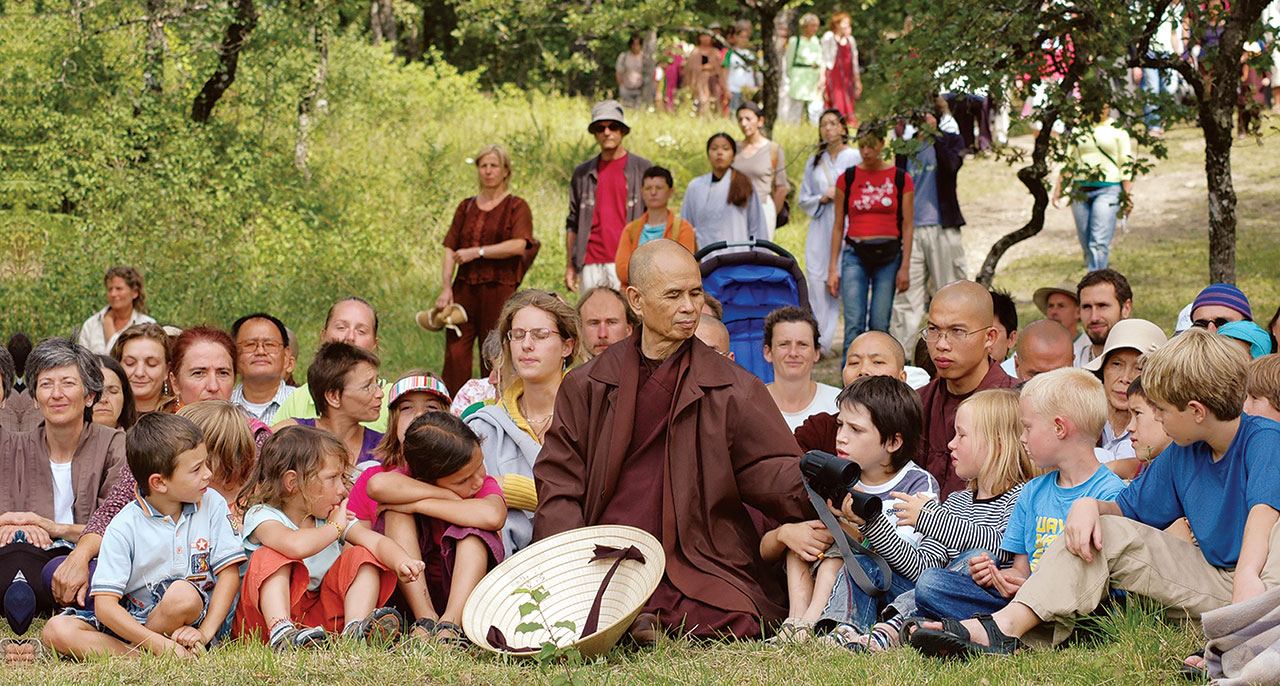
If that tycoon had been to Plum Village, if he had joined in a retreat, he would have already known these practices. With just several mindful steps or a few mindful breaths, he would have already brought his attention, his mind, back to his body.
He would have been there truly for his son and able to look at his son attentively and lovingly, with a smile on his lips. He would have been able to say, “My son, I’m truly here for you.” That’s all it takes.
We should keep in mind that the greatest gift we can give our loved ones is our presence — our true presence in the moment.
How can we love if we’re not there?
To love someone, we have to be there for them. If we’re never there for them, how can that be love?
Even when missus is sitting next to mister while he’s driving the car, if the attention of his mind darts to somewhere else, missus is excluded from mister’s circle of attention. Missus will then feel that she’s not loved.
For this reason, love means being there for your loved ones. Those loved ones are our son / daughter, our husband / wife / partner, etc. This is something very easy to do.
Once we’re truly present in the moment, we can do many wonderful things that bring about great happiness.
Firstly, we offer this true presence of ours to our loved ones.
“Do you know, honey, that I’m here for you today?”
Can mister do that? Mister only needs to take a few steps and take a few breaths in mindfulness to be truly there in the moment, to take care of missus and to dedicate joy and happiness to her by his being truly present.
It’s because mister is not there most of the time. Although his body’s there right next to missus, his soul is somewhere else.
And the second miracle we can do is recognize the presence of our loved ones.
Firstly, we offer our true presence. And secondly, we recognize the presence of our loved ones.
“Daddy, I know you’re still there for me, that’s why I’m very happy.”
That’s how a son or a daughter recognizes the precious presence of their father. There’s no father who doesn’t feel happy hearing that from his son or daughter.
“Daddy, I know you’re still there for me and I’m over the moon.”
Or we say to our husband/partner something like,
“Honey, I know you are still here, alive, not meeting with any kind of mishap or accident. I’m so grateful.”
That’s not something that we have to grit our teeth to do. That’s something any of us can do. And it’s very easy to do, actually. All it takes is practice, that’s all.
Let’s say, this evening, when getting home, you misters can give it a try. You can try taking a few in-breaths and out-breaths really mindfully to be truly present in the moment, letting go of the past, letting go of the future.
You stop ruminating about your projects and being frantic with worries so you can be truly present. Then looking your beloved wife in the eye, you smile and say, “Honey, do you know? I know you’re there, you’re still with me. This makes me very happy.”
That’s recognizing the presence of our beloved. When our presence, our existence, isn’t recognized, we don’t feel that we’re being loved. That’s the truth.
Let’s say, a disciple tells his/her/their teacher, “Dear respected teacher, I know you’re alive and well, and I’m grateful for all the favorable causes and conditions in the universe that allow you to still be here with me.”
Saying that, a disciple recognizes the precious presence of their teacher.
In the same way, a child can recognize the precious presence of their father, and a husband / partner can recognize the precious presence of their wife / partner.
We have to recognize the precious presence of our children. Later we may regret being ignorant of their presence now, because one day they will leave the nest to start their own, or they may, unfortunately, get in a life-threatening accident.
That’s why in this moment, we should appreciate what we’re having. And that includes our loved ones. Otherwise, if we fail to recognize each other’s precious presence, if we fail to dedicate to each other our true presence, it’s more than certain that everything we have now will be but a dream.
We definitely don’t want that. We don’t want our life to be but a dream. “Now the pair of us is unmistakably holding each other’s gaze, yet who knows it’ll become but a dream anon?”
I remember one day when I was walking in meditation in our mindfulness practice center in France, looking up to the sky, I was in awe of the magnificence of the moon and the stars. And I practiced with the moon and the stars, saying silently, “Dear moon, dear little stars, I know you moon and little stars are there for me, and I’m very happy.”
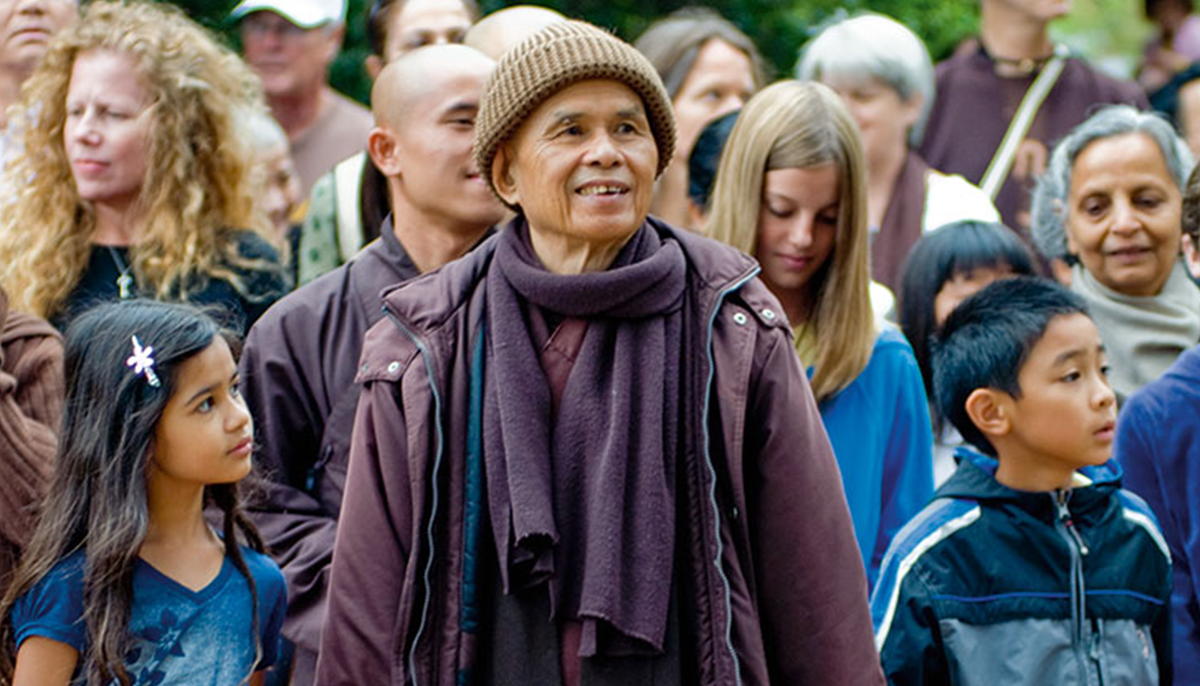
Well, what Kieu said, “Now the pair of us is unmistakably holding each other’s gaze” — who is that “pair of us” exactly?
That “pair of us” can be us and our daughter / son, or us and our husband / wife / partner, or us and our father / mother. That “pair of us” can be us and the moon. That “pair of us” can be us and the glorious sunset scene, the open blue sky, the scudding white clouds, the warbling birds, the cheering trees, or the blooming flowers.
All of those marvels are present in the moment. If we’re present in the moment, we can get in touch with these marvels in that moment.
That “pair of us” is us and the sun. That “pair of us” is us and the moon. That “pair of us” is us and a beautiful blossom.
Because we’re truly present, life is present for us. For that reason, the secret of life is to make sure we can bring ourselves back to the present moment to get in touch deeply with the miracles of life in any given moment.
In Buddhism, we learn that we can live happily in the present moment. One day, the Buddha received a group of 500 businesspeople led by Anathapindika. Of course, the Buddha knew these businesspeople tend to think of their successes in the future. So in his Dharma talk addressing these businesspeople, the Buddha said,
“Dear friends, do you know that you can live happily right in this moment?”
If you practice taking refuge in the Three Jewels within yourself well, if you practice the Five Mindfulness Trainings well, if you practice the Four Recollections well, you’ve already had the conditions to live happily in this moment.
The Buddha used the phrase “Ḍstadharma sukhavihāra.” In Sino-Vietnamese, it’s “hiện pháp lạc trú.” “Hiện pháp lạc trú,” or “hiện pháp lạc cư.” It means “living happily in the present moment.” “Hiện pháp” means what’s going on in the moment. “Lạc cư” or “lạc trú” means to live happily.
There’s one teaching that we rarely hear that is, the Buddha warned us not to be haunted by the past, and not to be terrified by the future. Let us come back and establish our body and mind in the present moment to be able to recognize the wonders of life and to recognize the conditions of happiness that we’re having in this moment.
It’s because most of us believe that it’s hard to be happy and content with what is in the present moment, that we need a couple more conditions to really be secure and happy. We’ve been restless, constantly in a rush, struggling to do whatever it takes to have what we think we still lack.
That’s why we’re trampling on this moment, and we’re rushing to the future.
To help you with this, there’s an exercise that you can experiment with. You take a pen and paper and write out the conditions of happiness that you’re having now. You can bring the paper and pen with you and sit under a tree, or on a blade of grass.
Then try writing out the conditions of happiness that you’re having. You’ll come to see you’re having a good many conditions of happiness. So many that you can’t write them all out.
You will uncover a profound truth that’s really happening to you that is, there are already so many conditions of happiness for you to be happy right away. Two pages won’t be enough to write down all these conditions of happiness.
For example, we practice like this,
“Breathing in, I am aware of my two eyes.
Breathing out, I smile to my two eyes.”
Practicing this way, we recognize one of our many conditions of happiness. Having two good eyes is a very important condition of happiness.
Imagine us being blind. How would we feel if we opened our eyes but couldn’t see anything? There’s a paradise of colors and images. Thanks to our having two good eyes, we can get in touch with that paradise at any given moment. Isn’t it a condition of happiness?
If we were blind, we would have to ask the other person to come near, and touch that person’s face with our two hands to remind ourselves how the other person looked like.
So, having two good eyes means having a great condition of happiness. Having two good ears means having a great condition of happiness. Having a normal heart is also a great condition of happiness.
Some people have cardiovascular conditions and they can have a heart attack at any time. Their deepest wish is to have a normal heart like everyone else. Meanwhile, we have a normal heart but we don’t feel happy at all when this condition is already available to us.
We just trample on such present conditions of happiness to run after something else.
Our spouse or our partner is now healthy and still living under the same roof with us, that is another condition of happiness. Our children are still strong, and they can go to school. They’re having all the favorable conditions to be successful students. These are such great conditions of happiness.
That’s why if you take this exercise seriously, you’ll come to realize two blank pages are simply not enough to write down all the conditions of happiness you’re having.
French people have a song called “What are we waiting for to be happy!” “Qu’est-ce qu’on attend pour être heureux! “
It’s because I see that you have so many conditions to be happy about right away. The Buddha taught, “Dear friends, bring your mind back to your body, and establish the mind and body in the present moment. With that, you can touch the miracles of life and you can see that the conditions of happiness you’re having are more than enough for you to be happy right away.”
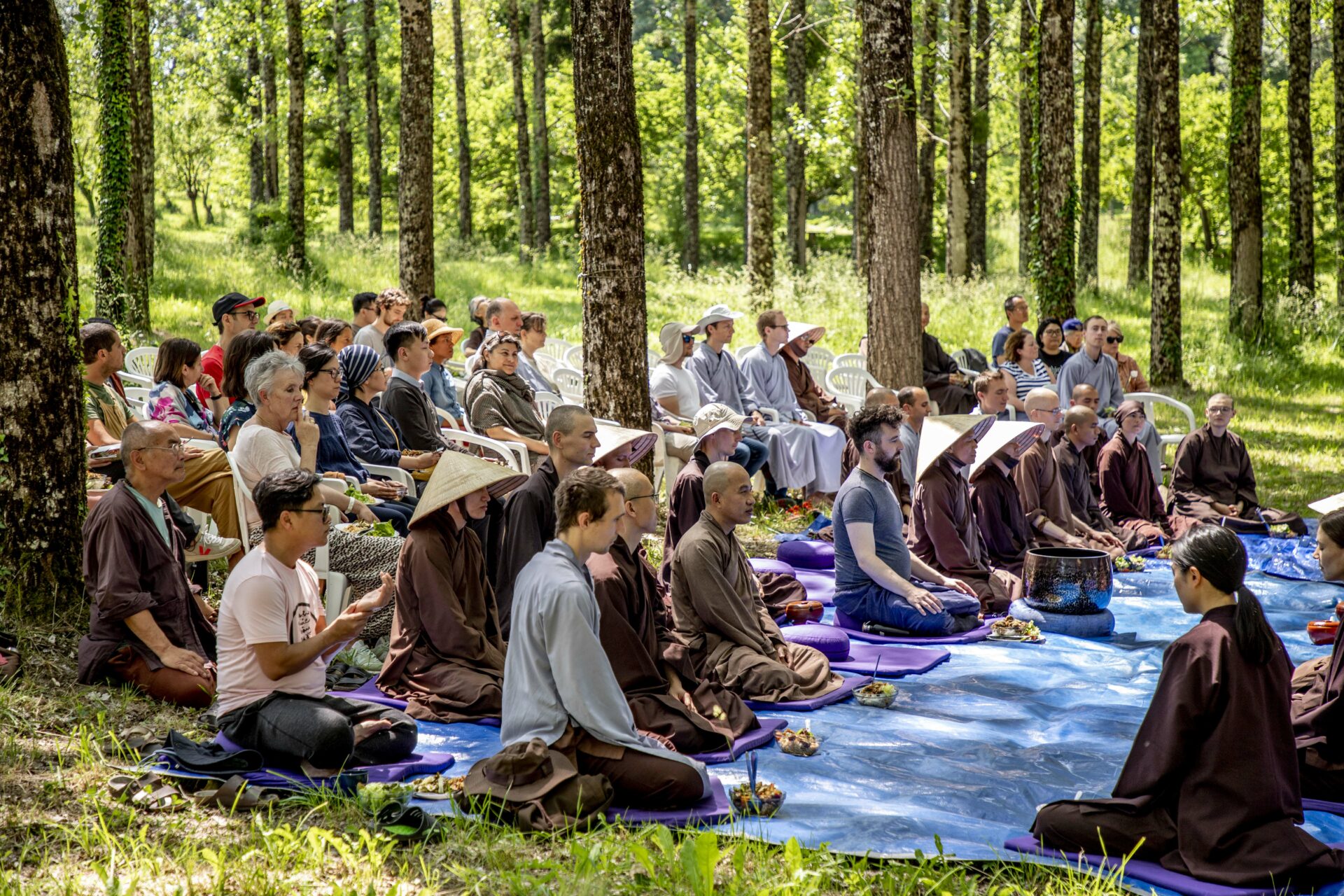
This teaching, this practice, is the answer to today’s world of busy-ness and restlessness, where everyone competes in ruthless pursuit of wealth, power, prestige, or status symbols to prove themselves. We count on science and technology. We count on the path of industrialization and modernization. And we believe that path will lead to happiness.
However, we know that the undertaking of industrialization and modernization and the applications of science and technology give rise to all sorts of social evils that are increasingly blatant in our society. Crime. Violence and hostility. Sexual misconduct. Drugs abuse and addiction. Corruption. Among others.
Because we have superstitions. We think happiness is only possible when we are successful in terms of science, technology, industrialization, wealth, power, fame, and prestige.
Meanwhile, happiness can be had right here and right now if we can dwell peacefully in this moment, recognizing the conditions of happiness already available in this moment.
You may ask us, “How, having been to America and Europe over the years, have you been so successful (at teaching mindfulness)?“
We’ve established thousands of communities that have practiced mindfulness this way all over Europe and the US. We only share with them this way of practice.
“Dear friends, don’t find happiness in the distant future. You should come back to the present moment, and you should recognize the conditions of happiness you’re having. You can train yourself to bring peace and contentment, and to bring solidity and stability into your body, heart, and mind. You can speak lovingly and listen calmly and deeply to re-establish communication between you and your beloveds in the family.”
It’s because there are fathers who can’t have a real conversation with their daughters / sons, and there are daughters / sons who can never have a real conversation with their fathers. There are also husbands / partners who can neither have a real conversation with nor look their wives / partners in the eye.
The mindfulness practices that we recommend are for fathers to have real conversations with their daughters / sons, for husbands / partners to have real conversations with their wives / partners, and for everyone to see for themselves that they’re not happy — not because they lack money, or fame, or power — but because they’re not mindful of the plentiful conditions of happiness they’re having. Instead, they’re trampling on those conditions to rush to the future.
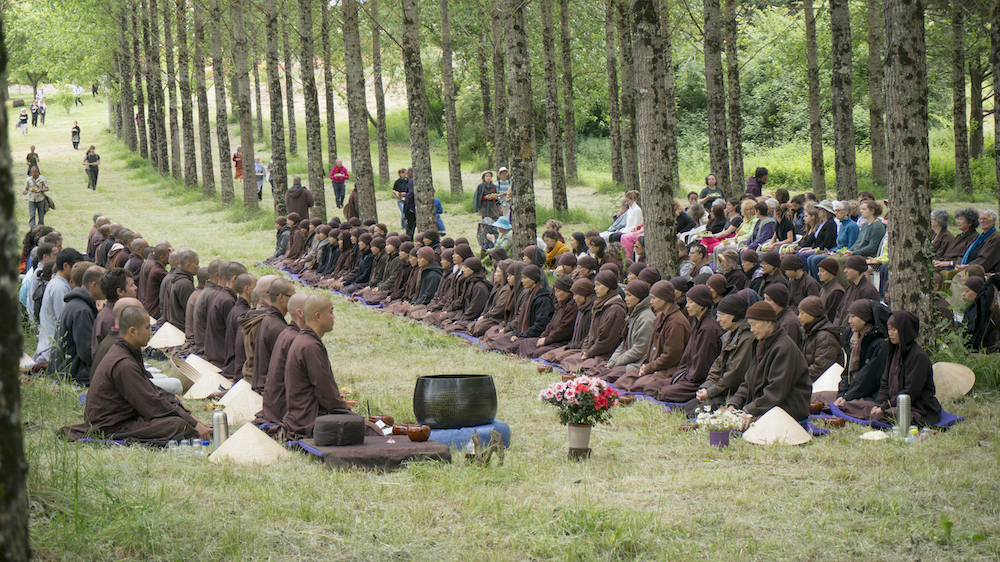
Well, our sharing is not theoretical. Because in Plum Village Monastery in France where we live and practice and in the mindfulness practice centers we founded in the US, first and foremost, we practice as a residential sangha, a residential community, with monks, nuns, and lay friends living together in hundreds.
Each comes from a different country or a different culture. But with this mindfulness practice, everyone can live with one another in peace, harmony, and happiness.
When we can live in happiness and harmony as a family, we can hold retreats for those who wish to learn and practice with us. Every year in Plum Village, we have thousands of people coming and practicing mindfulness with us.
Every summer, we usually have retreatants representing more than 40 countries. Besides the retreats held in Plum Village Monastery, we also organize teaching tours around Europe and the US.
And every day, those who come to train with us practice mindful breathing, mindful walking, mindful sitting, mindful tea-drinking, and mindful eating to get the hang of living in the moment peacefully, solidly, leisurely, and deeply.
Once they already know how to do these, we can help them learn to speak mindfully and listen mindfully so that they can re-establish communication with their father, mother, wife, husband, partner, daughter, or son — which in turn helps them reconcile themselves with themselves and restore happiness in the family. It’s a matter of practice, not theory.
[Bell]
5
Mindful consumption: The way out for us as a society
In Buddhism, we learn that we can have happiness with adequate conditions for living. There’s a teaching of “knowing we have enough“. When we’re capable of building brotherhood and sisterhood, father-son relationships, teacher-student relationships,…, even when we run a less luxurious car, even when we eat a less sumptuous meal, happiness is still as great.
In Buddhism, we talk about the Pure Land, symbolizing a realm of happiness. In Plum Village, we practice living in the Pure Land of the Present Moment. All the miracles of life can be recognized and in touch with if we’re able to come home to this moment.
If we know how to build brotherhood and sisterhood, if we get nourished by brotherhood and sisterhood, by the happiness generated by brotherhood and sisterhood, we can live a simple yet content and happy life.
When we know how to live a simple life happily, we no longer want to exploit natural resources on planet Earth. We no longer pollute the environment, and we leave behind a heritage for our children.
So, knowing we’ve already had enough, being easily satisfied with what we have, having few desires and cravings, is a way of living that can save the planet and leave a better future for our children and grandchildren.
I see our way of living right now destroys not only nature but also humans. I heard that here in Bình Định, violent crimes among youths are getting increasingly serious.
Just this morning, I received a letter. In this letter, they said,
“Even at school, children as young as 14 or 15 years olds gang up, and come against each other in bloody street fights and killings. Over trivial things, they easily get into shouting matches.
Recently, on Monday the 4th of April, 2005, a tragedy happened at Trung Vuong Senior High. Over a trivial matter at a classmate’s birthday party, they carried knives & sickles to school, waited for the rival members to appear at the school gate, and stabbed their schoolmates many times to death.
This act of killing was brutal and cold-blooded which could only be found in professional killer movies.”
In the West, as well as in Asia, industrial development has given rise to such social evils.
Moreover, young people nowadays over-consume movies, magazines, and media products that have graphic scenes displaying violence and hostility, acts of revenge, and sensual images. That’s why our children have easily picked up the substance of desires and violence and aggression from the contents and images in these media products. That’s why these social evils happen to us in real life.
In Buddhism, we learn that we have to protect our body, heart and mind. When we eat and drink, we have to be careful and mindful of what we eat and drink so that we don’t bring toxins into our body. When we consume media products such as books, magazines, movies, videos, photos,…, we have to consume them mindfully.
If we consume media products that contain toxins like sensual stimulation, rage, revenge-seeking, violence,…, well, they become poisons in our heart and mind and in the hearts and minds of our children and grandchildren.
That’s why observing the fifth mindfulness training i.e. mindful consumption, can help keep us as a society from those social evils.
That’s why one of the things Shakyamuni Buddha taught that we should take seriously is we should never strengthen the potentialities, or water the seeds, of violence and aggression, of sensual stimulation and pleasures, of rage and revenge-seeking in us by way of consumption.
That’s why if we really want to protect our children and grandchildren, if we really want to protect our society, we have to go on the path of mindfulness, which means producing and consuming everything mindfully.
Teachers, educators, and politicians in our country must pay special attention to this matter if we don’t want our society to go from bad to worse. I would like to stop right here to save some time for questions and answers.
🏵
Suggested readings
- The Five Mindfulness Trainings, https://plumvillage.org/mindfulness/the-5-mindfulness-trainings/
- Thich Nhat Hanh, 2012, Good Citizens: Creating Enlightened Society, California, USA: Parallax Press.
- Thich Nhat Hanh, The Dalai Lama, bell hooks, Joanna Macy, Bill McKibben et al., 2019, True Peace Work: Essential Writings on Engaged Buddhism (second edition, edited by Parallax Press), California, USA: Parallax Press. [First edition titled “Engaged Buddhist Reader”, edited by Arnold Kotler].
- Thich Nhat Hanh, 2011, Our Appointment with Life: A Commentary on The Sutra on Knowing the Better Way to Live Alone, California, USA: Parallax Press.
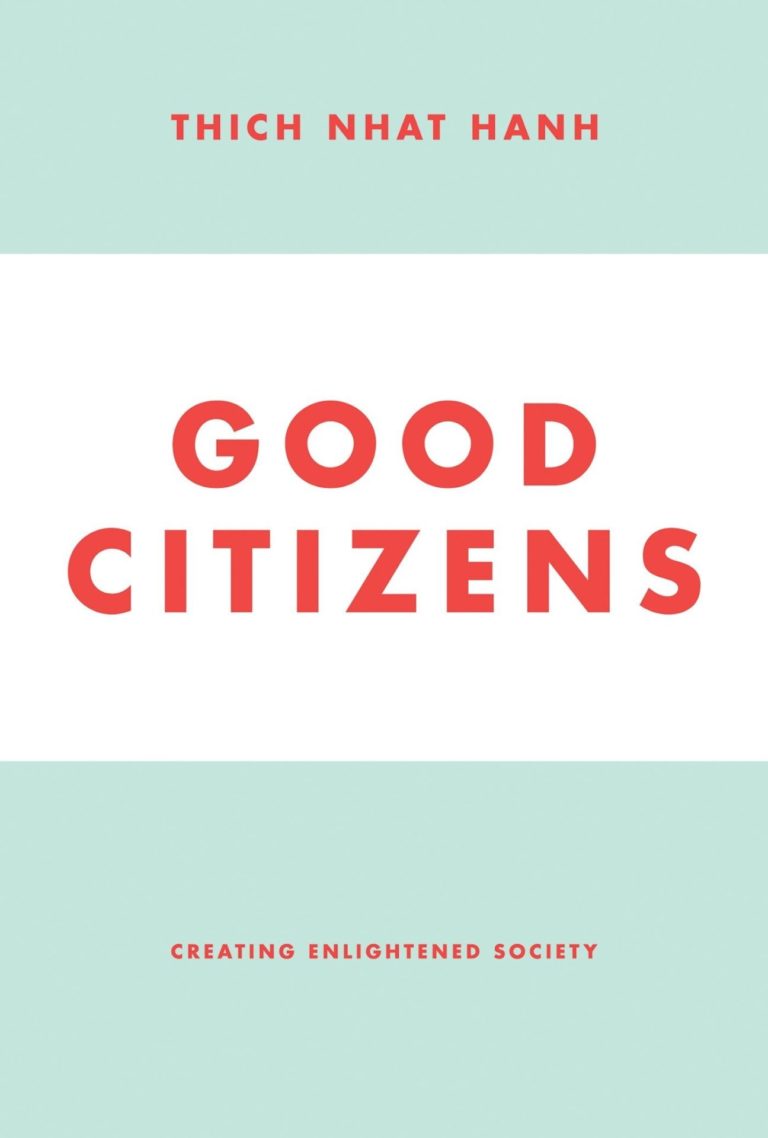
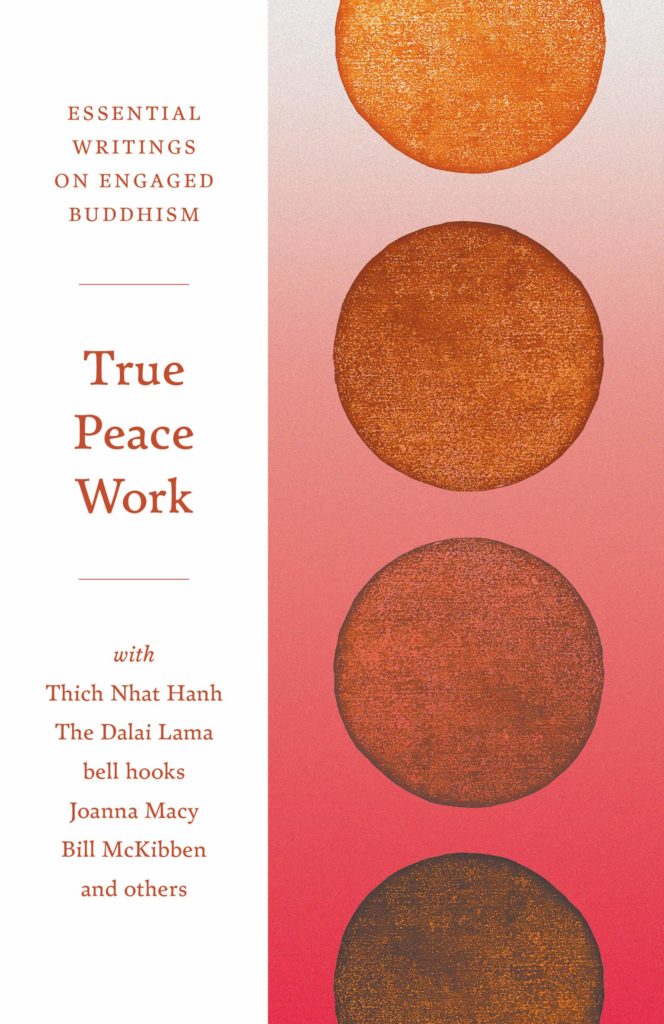
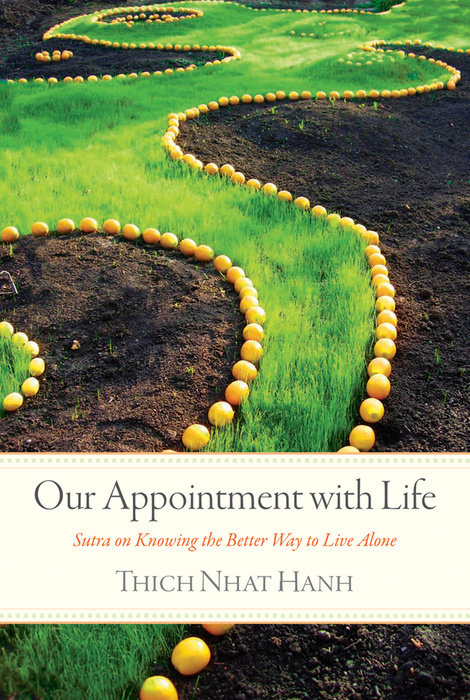
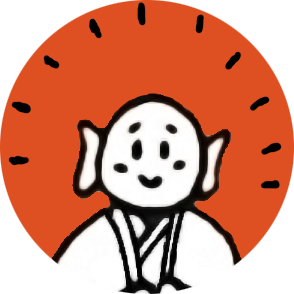
Leave a comment